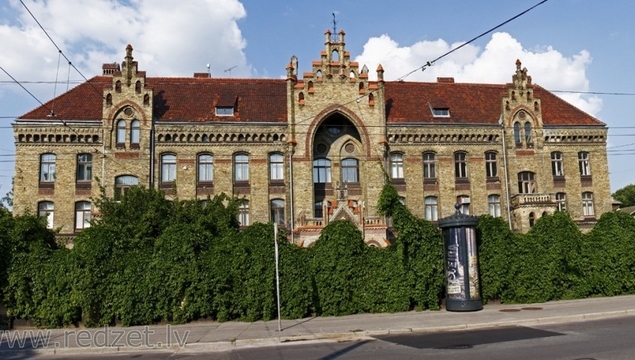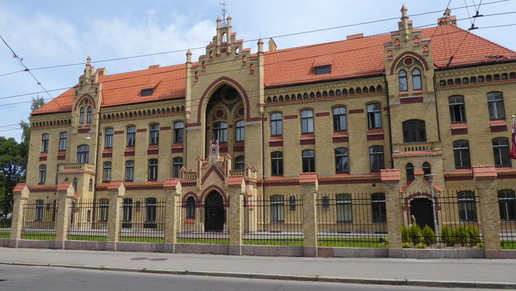A "Deferred Maintenance" Metaphor
|
|

Caption: BEFORE – Note the stifling overgrown shrubbery.

Caption: AFTER – Untangled, landscaped and restored. Photo by author, July 2017.
Across the street from where we live in Riga, Latvia is the campus of the First Riga Hospital (est. 1803).
In 2011, when I had my Fulbright to teach at the University of Latvia, the main building looked pretty much like in the BEFORE picture. I walked past that visually impenetrable fence daily to catch my bus for where I teach.
This June, I was amazed to see that under the unkempt jungle was a beautifully rendered fence matching the Art Nouveau architectural style of the main building.
The fence was once again a thing of beauty anchored in rose colored granite, the first level was again revealed with a small apron of lawn setting off the curving drive, and the building soared from ground to tiled and turreted roof.
I was taken with the contrast. This sudden Cinderella transformation of what had been a grim, unwelcoming building suggested to me what can happen in some organizations. We become depressed by decades of inaction, decades of postponed decisions, decades of waiting for additional funding to get us to where we want to be - a deferred maintenance of the organization’s spirit, not just the physical facility.
While lack of money can inhibit service provision, often, if we have the will, we can make low cost improvements. Those remarkable improvements at the Riga First Hospital came about by clearing away some of the undergrowth, cleaning and restoring the high quality stone, brick and metal, and painting the fence – opening up the view from outside and, importantly, from within.
That sort of dramatic improvement can often be done within existing resources – it’s a matter of implementing a plan to get the most benefit for the organization’s workers, its clients, and how its community perception.
I recall doing something like this when we took a step-by-step reduction and elimination of backlogged materials in a large research library. As we chipped away steadily, there was a perceptible freeing up of the organizational spirit, a realization that we could do it, that we were not bound to a perverse pride of achievement in having a large backlog.
Instead we tackled it, brought it under control and within a few years eliminated it.
Our leader at the time termed those backlogs an albatross, choking the organization, impeding its progress, and stifling innovation because we had to cope with this growing jungle of unfinished work. He was right.
Most rewarding of all was that we did it with existing staff and resources. That achievement encouraged many in the organization to take on additional challenges and not settle for second or third best.
As we streamlined and freed up staff from routines, we were then able to move that extra staff to other parts of the organization, specifically service points for students and faculty.
For the next several years what had been a stodgy organization gained a sense of urgency, became vibrant, full of innovation, and gained additional support from the parent organization.

Caption. Close up of the restored fence on the pinkish granite stone. Photo by author.
________________________
N.B. My next book, Fables for Leaders, Ezis Press, comes out in September 2017 as an e-book ($3.99) and a soft cover book, ($24.99). The print book will feature original illustrations by the renowned Béatrice Coron.
ISBN: 978-0-692-90955-3
LCCN: 2017908783

Cover: "Fables for Leaders" PRE-PRINT, 203pp. 2017.
Update. The book has been printed as a Riga edition of 30, numbered copies. Ten have been given to friends and libraries in Latvia. The balance will be sent to review media in the USA.
© Copyright John Lubans 2017
 John Lubans - portrait by WSJ
John Lubans - portrait by WSJ